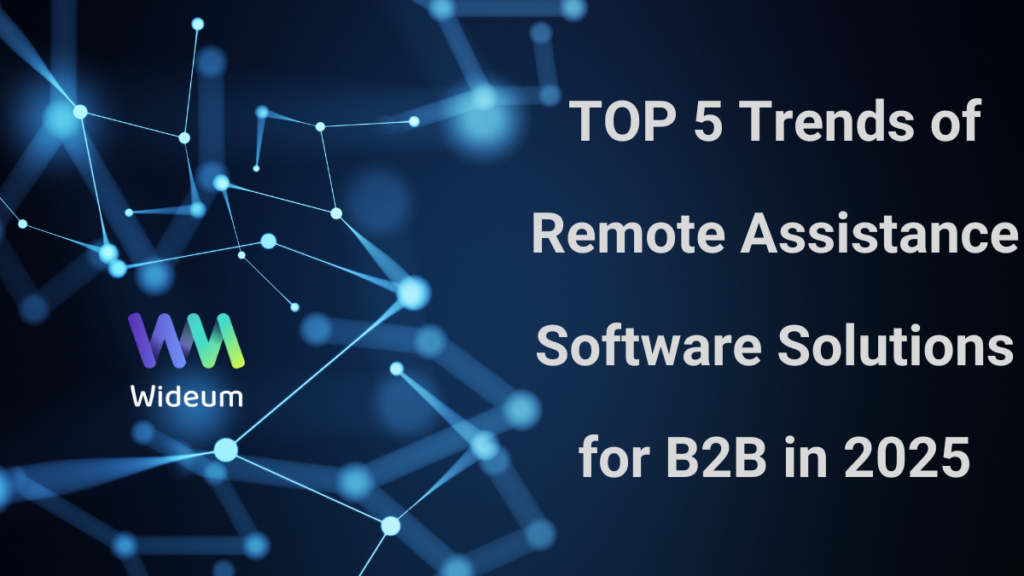In 2025, remote assistance software has become a critical tool for B2B companies to streamline operations, deliver exceptional support, and foster strong relationships with enterprise clients. The rapid pace of technological advancements has shaped new trends in the industry, helping businesses address complex challenges and deliver more efficient solutions. Let’s dive into the top 5 trends shaping remote assistance software for B2B this year.
1. AI-Driven Support for Enterprise Efficiency
Artificial Intelligence (AI) is transforming remote assistance software for B2B companies by increasing efficiency and providing smarter solutions to complex issues. AI-powered tools now enable:
- Predictive issue detection, allowing businesses to proactively address client concerns before they escalate.
- Intelligent ticket routing, ensuring the right specialist handles the right problem, saving time and resources.
- Real-time recommendations for support agents, enhancing their ability to resolve client issues faster.
For B2B businesses, this means reduced downtime for clients and a more efficient use of internal resources. AI-powered insights also help B2B companies create tailored solutions for their enterprise clients, improving overall service quality.
2. AR (Augmented Reality) for Technical B2B Support
In industries like manufacturing, engineering, and IT, where complex systems and machinery are common, AR-based remote assistance solutions are game-changers. For B2B companies, AR tools allow:
- Remote troubleshooting of technical equipment with 3D visual overlays and annotations.
- Step-by-step guidance for clients’ on-site teams, reducing the need for travel by service technicians.
- Enhanced product demonstrations and training sessions, boosting client satisfaction.
For example, a B2B equipment supplier can use AR to assist its enterprise clients with maintenance or operational issues in real time, leading to faster resolutions and stronger client relationships.
3. Integration with Enterprise Ecosystems
B2B organizations often rely on a suite of enterprise-grade software solutions to manage their operations. Remote assistance software in 2025 is designed to seamlessly integrate with popular enterprise tools, including:
- CRM platforms like Salesforce, HubSpot, or Zoho, enabling businesses to track client interactions and histories effortlessly.
- ERP systems for managing workflows and ensuring smooth collaboration with clients’ internal systems.
- ITSM tools like ServiceNow and Jira, for streamlined IT support processes.
This integration allows B2B companies to create end-to-end workflows where customer issues can be tracked, escalated, and resolved without switching between platforms. The result is a more cohesive and efficient client support process.
4. Heightened Focus on Security and Compliance
Security is a top priority for B2B companies, especially when handling sensitive client data. In 2025, remote assistance solutions emphasize enterprise-grade security features to meet the compliance needs of global businesses. Key advancements include:
- End-to-end encryption to protect communication and data exchange.
- Advanced access control with zero-trust architectures, ensuring only authorized personnel can access client systems.
- Compliance with international regulations like GDPR, HIPAA, and ISO 27001, giving businesses confidence when dealing with sensitive industries, such as healthcare, finance, and government clients.
For B2B providers, these features build trust with their clients, ensuring their data and systems are safe during remote interactions.
5. Use of Wearable Devices to Enhance Field Service Support
One of the most exciting trends in the B2B remote assistance software space is the integration of wearable devices, such as smart glasses. Companies like Wideum are leading the charge, developing solutions that empower field technicians and enterprise clients with hands-free, real-time support. Here’s how wearables are transforming B2B remote assistance:
- Remote guidance: Experts can provide real-time support to field technicians wearing smart glasses, enabling them to resolve issues faster while keeping their hands free to work.
- Live visual collaboration: Wearables transmit live video and audio feeds, allowing experts to see exactly what the technician sees and guide them step-by-step.
- Increased efficiency: By leveraging wearable technology, technicians can access manuals, instructions, or AR overlays directly in their field of view, reducing errors and increasing productivity.
For example, a B2B company in the industrial sector can use Wideum’s remote assistance solutions to support field service teams, ensuring quicker problem resolution and reducing the need for on-site visits. This not only saves costs but also improves client satisfaction by minimizing downtime.
B2B organizations can stay ahead
The B2B landscape in 2025 is shaped by cutting-edge technologies that enable remote assistance software to be smarter, faster, and more collaborative. From AI-powered automation to wearable devices for hands-free support, these trends are helping B2B companies deliver exceptional value and build stronger relationships with their enterprise clients. By adopting tools that integrate seamlessly with enterprise ecosystems, prioritize security, and leverage AR or wearables for real-time guidance, B2B organizations can stay ahead of the curve and thrive in a highly competitive global market.

